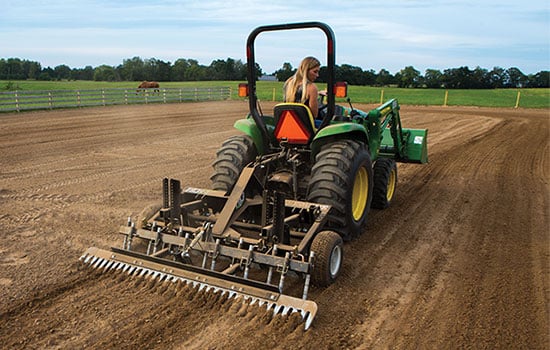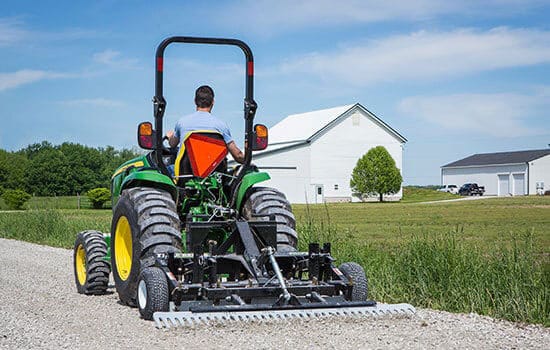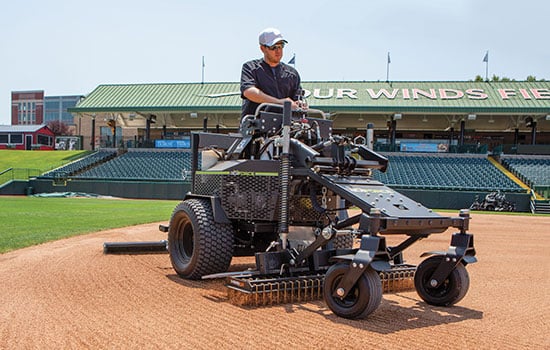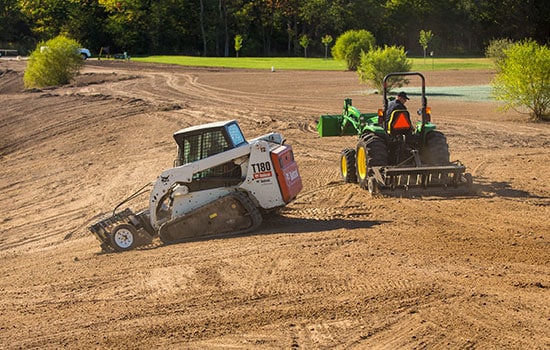ABI Dirt – Answering Your Questions!
Transcript
Hi, everyone. Matt Metzger here with ABI Attachments, welcome back to another episode of ABI Dirt. Today we’re going to try something new. You all are fantastic about leaving us questions and comments on our social media pages. We’ve read through some of your questions and we’re going to try to tackle some of them today. So please keep those questions coming. If you want to be featured on an episode of ABI Dirt, when you leave us a question about a product, about something we do here, say, hey, I want this answered on ABI Dirt. Let us know. We’ll take a look and we’ll see what we can do.
For a 33 horsepower Kuboda, we would typically recommend a six and a half foot TR3. Now I say typically because there’s way more factors that go into this decision than just the horsepower requirements. We take a look at width the tow vehicle, weight of the two vehicle, three point lift capacity, tires, whether turf or agg. And that’s before we’re even talking about the project that you’re working on. What are you trying to accomplish? What work do you need to do? So you can see there’s a lot of factors that go into matching up the right attachment to the right situation. We really want you to give us a call so our factory rep can talk you through all of those questions. So six and a half TR3, I’d normally recommend for a 33 horsepower tractor, but give us a call and let’s match it up exactly.
Now, to help you get started trying to decide what tool might be the right fit for you. We do offer a specifications page on every one of our product pages online. So if you’re online, if you’re taking a look at one of the products you like the look of, look for that specification subtab. Click into it. It gives you all the specs there to help you get a head start before you talk to a factory rep. Great question, Jaimie. Thank you.
Going to take forever to grade a driveway because of how light it is. Braedon forever’s a long time like sands of the seashore long. You’ve got to give us a little bit of credit here. It will take longer for sure. But Braedon, I mean, you make a good point, man. I mean, we’ve got a that gravel grader has a four foot wide box. Will it take a long time to grade a gravel driveway? Yes, compared to a tractor with a three point attachment behind it. Now we make attachments for all different kinds of tool vehicles, lawnmowers, four wheelers. ATV is UTV, skidsteers, big tractors, small tractors. And I’m here to tell you, any factory rep you talk to is going to say, if you’re doing gravel work and gravel driveway work and you have got a tractor, get a three point attachment, make it worth your time and money. Right? If you don’t have a tractor, if you don’t have a side by side or a four wheeler and what you’ve got is a gravel driveway with a lawnmower. Now, let’s talk about the ABI Gravel Grader. Nothing out there compares to its ability to decompact, actually rip up, get to the heart of potholes and also have that box there to carry material.
So Braiden completely agree with you. Maybe not forever. It would take a much longer time to use a gravel grader behind a lawnmower then it would be a tractor with a three point attachment. Completely agree. If what you’ve got is lawn mower, the gravel grader is a phenomenal option and you should definitely talk to a factory rep about whether or not it’s right for you.
Vick, if you are composting for six months, your soil in your pastures must love you to death. That’s awesome. Not everybody has the time or the space available to compost their manure. Glad that you get to that’s going to be fantastic for the nutrients in your soil. Now, Can the ABI classic spreader handle cow manure? You bet. Throw us your worst. I would recommend, however, looking at the eighty five cubic foot or up sizes. We have more of a commercial build to the eighty five and up sizes that would allow you multiple features, make it better for cow manure. If you’re using a skidsteer or a tractor loader to fill that manure spreader up. Eighty five it up is much better because the sizes it gives you a wider area to dump into those smaller sizes and the ground drive units are intended to be more maneuverable inside of barns that are actually picking stalls as they go and they can roll it right back out the barn.
So take a look again, referencing earlier in the show about those spec sheets on the product pages that it’s going to tell you how many animals we recommend for different size of spreaders. So small number of animals, smaller spreader. But you’ve got wet cow manure, absolutely jump up to that eighty five size or higher and you grab that PTO model as well. You’ll work through that. The Manure spreaders eat poop for breakfast, lunch and dinner. Thanks, Vic. Great question.
Carl, I can see why you would you would come to that conclusion. Taking a look at some of the video footage of that SR1 pushing some gravel and preparing a gravel driveway. Totally get it when you’d get there. But the rock bucket and the SR1 have two fundamentally different purposes. So we’re whereas the rock bucket is designed to be able to scoop up material, shake it, sift it, grab any rock that’s two inches wide or bigger, and then dump it off to the side. We see rock collection as one step in a multi-step process of soil preparation. So whereas we’re thinking about preparing horse arenas, preparing driveways, preparing seedbeds, preparing landscaping, and that involves rock collection, the bucket, the rock bucket is just intended to actually get those rocks out of there. So, for example, if you’ve got a rock bucket and you are sifting through and pulling rock out when you’re done getting the amount of rock out that you want. Next question is, well, what do you try to accomplish with the land? Right? You need to prepare it. If it’s anything for seedbed, you still need to decompact the soil that’s remaining after you pull that rock bucket out, because in order to plant anything and stand a good chance of growth, you’ve got to let those roots go down deep. That means you need to decompact. I know that some rock buckets by pulling across, you could use some decompaction, but typically you’re only going to get about two inches of decompaction with a rock bucket, whereas an SR1 those multipoint scarifiers you’re able to rip four six inches deep with an SR1, whereas you’re not going to get near that deep, which means you’re not going to get that that root growth that you want. If you’re doing if you’re doing seedbed preparation. Carl. Great question.
That’s all the questions going to tackle today, folks. We’d love more questions to tackle, though. So along with subscribing to this channel, jump over to our social media pages, Facebook, Instagram, follow us there. That way, you can submit your questions. Let us know that you saw us on ABI Dirt and you want your questions answered as well. We’ll do our best to tackle them in future episodes, but until next time, take care.



